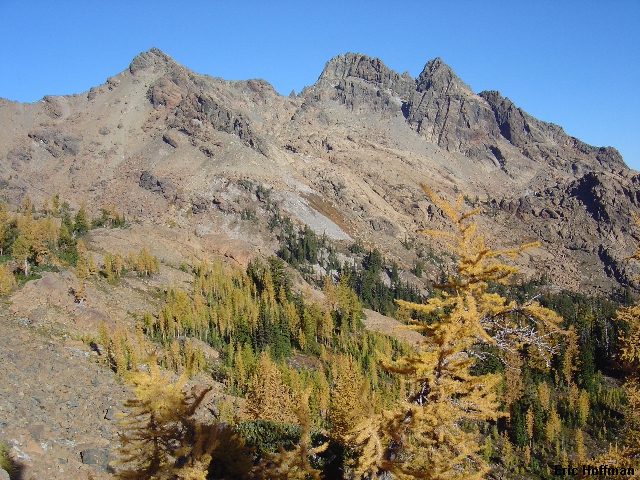South, North and East Ingalls Peaks from near Ingalls Pass

Andy and I had vowed to return to climb the ever popular South Face route on North Ingalls Peak since last fall when we founded conditions to be less than ideal and ended up settling for the less interesting south peak instead. We thought we’d give it a try earlier this year and made the drive to the Esmeralda Basin Trailhead. The trailhead was busy, real busy. We decided to climb Esmeralda Peak instead. In hindsight Esmeralda was probably more challenging but not necessarily more enjoyable than North Ingalls.
|
South, North and East Ingalls Peaks from near Ingalls Pass |
|
|
|
Ingalls Lake and Mount Stuart from the approach to the North-South Peak col |
|
|
This time we planned our assault on a Friday hoping that would at least reduce the crowds. We would still end up seeing three other parties on the peak but two of those were on the East Ridge and the other party on the South Face moved at such a different pace that we managed to stay out of each others way.
Leaving the trailhead at about 8:00am, it took us about three hours to reach the saddle between the north and south peaks. We arrived there at the same time as the other party despite having left the Seattle area two and a half hours after them. We roped up while they ate a snack. I asked Andy, "Did ya read the route description last night?"
"Nope, did you?" Andy replied.
My answer was the same so it appeared we would have to rely on our memory but my memory is bad enough that I can’t remember if I had read the route description before either of the other trips. All I remember was at some point in life reading about a "yellow overhang," so we were probably going to have to figure it out. It is far from a difficult route to figure out but knowing the rating of the variations may allow you to make it more interesting than we did.
We started the route on the east side of the saddle just below the Dog tooth Crags scrambling up class 3 and easy 4 blocks except for a couple harder moves on a slab just before reaching a large debris covered ledge. A gully reaches the ledge from the west side of the north-south peak saddle (this is the gully that Beckey describes as the start of the route, class 3). By this time the rope had some serious drag and I wanted Andy’s opinion of where we should go next. I lead to the edge of the face on the right and hauled in the rope. Andy took lead and headed up along the exposed edge passing a rappel sling near the yellow overhang then traversing out onto the face then up to a ledge with two bolts (5.4). "The central crack" is apparently 5.6 and the more interesting route from the large ledge to the first two bolts.
|
Andy at the belay ledge above the "Yellow Overhang" |
|
|
Andy belayed me to the bolts and I took lead placing one cam before climbing a short step at the top left corner of the south face slabs. The 2nd pitch is class 5.0 at best with three bolts on top for a belay/rappel anchor. I pulled up over the step expecting there to be more climbing but there wasn’t. We reached the summit about an hour after roping up. Curiously, there was no summit register...
|
Andy still at the belay station |
|
|
We relaxed on the summit for a while before making our way back to the rappel anchor. The leader of the second party was at the two bolts lower down. It was taking them a while and not wanting to wait we asked if they minded if we rappelled past them. They agreed and we made the first rappel to join the leader at the next rappel anchor. Our 50m rope was not long enough to reach the bottom of the slab so we rappel down and to the right (climber’s right) where we had noted another rappel anchor near the yellow overhang. This rappel anchor is a bit sketchy and it is better to down an open book below the yellow overhang then down climb the rest of the route (exposed but broad ledge then class 3).
|
Lemah Mountain and Chimney Rock from the summit of North Ingalls Peak |
|
|
|
Andy rappelling past another party on the south face |
|
|
We dropped down the west side gully and noted the friction slab at the base of the SW face route. It was only about 1:00pm so we figured we might as well give it a shot. Above the friction slab (class 4) we continued up on lower angled slabs then traversed ledges. I believe we were higher than the normal route but there are many variations possible on the very loose rock. We finally ended up climbing a short steep gully (loose class 4) that quickly led to the 3 bolts at the top of the south face slabs (half hour from the base of the friction slab). The leader of the second group was belaying his partner who was finally reaching the top of the slab.
We rappelled down again and returned to our cache of gear below the saddle. Of these two routes the south face route is certainly the better one. The rock is solid and the climbing a bit more interesting.
|
Andy at the bottom of the friction slab on the SW face |
|
|
References:
Cascade Alpine Guide, Volume 1, 2nd Edition; Fred Beckey; Pages 286-88, 289
Climbing Washington's Mountains; Jeff Smoot; Pages 185-189